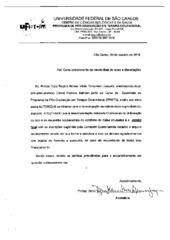| dc.contributor.author | Dahdah, Daniel Ferreira | |
| dc.date.accessioned | 2019-10-22T13:42:13Z | |
| dc.date.available | 2019-10-22T13:42:13Z | |
| dc.date.issued | 2019-08-09 | |
| dc.identifier.citation | DAHDAH, Daniel Ferreira. O processo de elaboração do luto e as respostas ocupacionais no cotidiano de mães enlutadas. 2019. Tese (Doutorado em Terapia Ocupacional) – Universidade Federal de São Carlos, São Carlos, 2019. Disponível em: https://repositorio.ufscar.br/handle/ufscar/11967. | * |
| dc.identifier.uri | https://repositorio.ufscar.br/handle/ufscar/11967 | |
| dc.description.abstract | INTRODUCTION: Bereavement is a process that occurs with the loss, by death, of a significant person. This is a painful experience that leads to the need to adapt to the new situation. Maternal bereavement becomes peculiar because it reverses the expected cycle of life, generating feelings of guilt and shame, accompanied by grief and the feeling of having failed in the role of mother. Occupations change during the bereaved process, as their constituent elements - doing, being, becoming and belonging – are affected, causing a crisis in maternal daily life. AIM: To understand the bereaved mothers’ occupations in their everyday life. METHOD: A cross-sectional, exploratory and qualitative study that used the Oral History technique, in the biographical narrative modality. The inclusion of the participants came from a group of mutual aid and selection, by the “snowball” technique. Ten mothers are included in the study. The data were generated from three collection instruments: field diary, timeline, and semi-structured interview. The results were categorized and analyzed by content analysis using deductive and inductive methods. RESULTS: In the field diary, the main topics addressed in the mutual help group were recorded. The timeline allowed us to visualize the “birthday reactions” and to identify, chronologically, the mothers' experience during the dates associated with bereavement. From the interviews, six categories emerged: The notification of the death of the son; The experience of motherhood before and after the death of the son; The meanings constructed by mothers after the death of their son; The future; Religiosity and spirituality helping to coping with bereavement; and, Occupational responses in the face of changes imposed on the everyday lives of bereaved mothers after the death of their sons. From the results, it was possible to systematize the occupational responses in the daily lives of bereaved mothers. DISCUSSION: Triangulation was used as a methodological strategy to broaden the understanding of the studied phenomenon. Identified that mothers perceived their personal and spiritual growth, found meaning and benefits in loss, did the changes in identity necessary to continue life. Also, they regain familiarity with their surroundings and was able to live authentically in everyday lives, enabling them to felt happy again. The results reaffirmed the bereavement process as a singular and individual experience, however, intensely permeated by social aspects, and mainly related to social and emotional support for coping with the bereavement. The study contributed to the understanding of the process of adaptation to bereavement through the occupational responses in maternal everyday life. Thus, depending on the form, purpose, and meaning of the occupational responses presented after to the death of the son, it was possible to categorize them into adaptive strategies that help the mother to adapt occupationally in everyday life. Besides, they support the reconstruction of meanings in response to bereavement and changes in everyday life and occupations. They also allow revisions about themselves, about desires, priorities, and the continuity of life in the world profoundly modified by the reality of the son's death. CONCLUSION: The occupational therapist, by identifying the elements of the bereavement adaptation process, assists the mothers in the reconstruction of the occupational meanings, in the encounter with the familiarity of the environment and in the accomplishment of the necessary changes for the continuity of life, repositioning in practical and emotional terms the absence of the deceased son in everyday life. | eng |
| dc.description.sponsorship | Coordenação de Aperfeiçoamento de Pessoal de Nível Superior (CAPES) | por |
| dc.language.iso | por | por |
| dc.publisher | Universidade Federal de São Carlos | por |
| dc.rights | Attribution-NoDerivs 3.0 Brazil | * |
| dc.rights.uri | http://creativecommons.org/licenses/by-nd/3.0/br/ | por |
| dc.rights.uri | http://creativecommons.org/licenses/by-nd/3.0/br/ | * |
| dc.subject | Terapia Ocupacional | por |
| dc.subject | Luto | por |
| dc.subject | Mães | por |
| dc.subject | Atividades cotidianas | por |
| dc.subject | Adaptação ocupacional | por |
| dc.subject | Occupational therapy | eng |
| dc.subject | Bereavement | eng |
| dc.subject | Mothers | eng |
| dc.subject | Activities of daily living | eng |
| dc.subject | Occupational adaptation | eng |
| dc.title | O processo de elaboração do luto e as respostas ocupacionais no cotidiano de mães enlutadas | por |
| dc.title.alternative | The bereavement elaboration process and the occupational responses in the everyday lives of bereaved mothers | eng |
| dc.type | Tese | por |
| dc.contributor.advisor1 | Joaquim, Regina Helena Vitale Torkomian | |
| dc.contributor.advisor1Lattes | http://lattes.cnpq.br/7719481657895650 | por |
| dc.description.resumo | INTRODUÇÃO: O luto é um processo que se produz com a perda, por morte, de uma pessoa significativa. É uma experiência dolorosa que conduz para a necessidade de adaptação à nova situação. O luto materno torna-se peculiar, pois inverte o ciclo esperado da vida, gerando sentimentos de culpa e vergonha, acompanhado de pesar e a sensação de ter falhado no papel de mãe. As ocupações sofrem alterações durante o processo de luto, pois seus elementos constitutivos - fazer, ser, tornar-se e pertencer - são afetados, provocando uma crise no cotidiano materno. OBJETIVO: Compreender as ocupações no cotidiano de mães enlutadas pela morte de um filho. MÉTODO: Estudo transversal, exploratório e de abordagem qualitativa que utilizou a técnica da História Oral, na modalidade narrativa biográfica. A inclusão das participantes partiu de um grupo de entreajuda, selecionadas pela técnica “bola de neve”. Dez mães participaram do estudo. Os dados foram gerados por meio de três instrumentos de coleta: diário de campo, linha do tempo e entrevista semiestruturada. Os resultados foram categorizados e analisados por análise de conteúdo, utilizando modelos aberto e indutivo e fechado e dedutivo. RESULTADOS: No diário de campo, registrou-se os principais temas abordados no grupo de entreajuda. A linha do tempo permitiu visualizar as “reações de aniversário” e identificar, cronologicamente, a vivência das mães durante as datas associadas ao luto. Das entrevistas, emergiram seis categorias: A notícia da morte do filho; A vivência da maternidade antes e após a morte do filho; Os significados construídos pelas mães a partir da morte do filho; O futuro; A religiosidade e a espiritualidade auxiliando o enfrentamento do luto; e, Respostas ocupacionais face as mudanças impostas no cotidiano de mães enlutadas pela morte do filho. A partir dos resultados, foi possível sistematizar as respostas ocupacionais no cotidiano das mães enlutadas. DISCUSSÃO: A triangulação foi utilizada como estratégia metodológica, com o intuito de ampliar a compreensão do fenômeno estudado. Identificou-se que as mães percebem seus crescimentos pessoal e espiritual, encontram sentido e benefícios na perda, realizam as mudanças na identidade, necessárias para continuar a vida. Além disso, retomam a familiaridade com o entorno e conseguem viver de forma autêntica no cotidiano, possibilitando sentirem-se felizes novamente. Os resultados reafirmam o processo de luto enquanto vivência singular e individual, porém, intensamente permeada por aspectos sociais, principalmente relacionados ao suporte social e emocional para o enfrentamento do luto. O estudo contribui para a compreensão do processo de adaptação ao luto através das respostas ocupacionais no cotidiano materno. Assim, a depender da forma, do objetivo e do significado das respostas ocupacionais apresentadas em resposta a morte do filho, é possível categorizá-las em estratégias adaptativas que auxiliam a mãe a adaptar-se ocupacionalmente no cotidiano. Para além, apoiam a reconstrução de significados em resposta ao luto e às alterações no cotidiano e nas ocupações. Também permitem revisões sobre si mesmas, sobre desejos, prioridades e sobre a continuidade da vida no mundo profundamente modificado pela realidade da morte do filho. CONCLUSÃO: O terapeuta ocupacional, ao identificar os elementos do processo de adaptação do luto, auxilia as mães na reconstrução dos significados ocupacionais, no encontro com a familiaridade do entorno e na realização das mudanças necessárias para a continuidade da vida, reposicionando em termos práticos e emocionais a ausência do filho falecido no cotidiano. | por |
| dc.publisher.initials | UFSCar | por |
| dc.publisher.program | Programa de Pós-Graduação em Terapia Ocupacional - PPGTO | por |
| dc.subject.cnpq | CIENCIAS DA SAUDE::FISIOTERAPIA E TERAPIA OCUPACIONAL | por |
| dc.description.sponsorshipId | CAPES: 88881.132578/2016-01 (PDSE) | por |
| dc.publisher.address | Câmpus São Carlos | por |
| dc.contributor.authorlattes | http://lattes.cnpq.br/5331569022443995 | por |


